by Lisa Cooke | Nov 3, 2019 | 01 What's New, Records & databases
The newest genealogy records to hit the Internet are exciting because of the wide range subjects they cover. Peruse these carefully because there just may be a genealogy gem waiting just for you!
New and Updated Free Records from FamilySearch
The newest additions to the FamilySearch collections are global in their reach, and best of all they are free. Here’s the latest:

American Samoa
American Samoa, Vital Records, 1850-1972
2,874 Added indexed records to an existing collection
Argentina
Argentina, Salta, Catholic Church Records, 1634-1972
98,907 Added indexed records to an existing collection
Brazil
Brazil, Santa Catarina, Civil Registration, 1850-1999
4,072 Added indexed records to an existing collection
Canada
Manitoba Church Records, 1800-1959
58 Added indexed records to an existing collection
Chile
Chile, Catholic Church Records, 1710-1928
2,670 Added indexed records to an existing collection
Colombia
Colombia, Bogotá, Burial Permits, 1960-1991
18,221 Added indexed records to an existing collection
England
England, Oxfordshire Parish Registers 1538-1904
826 New indexed records collection
England, Yorkshire Marriage Bonds and Allegations, 1613-1887
960 New indexed records collection
England, Bedfordshire Parish Registers, 1538-1983
376,993 New indexed records collection
England, Devon Bishop’s Transcripts, 1558-1887
33,158 Added indexed records to an existing collection
England, Warwickshire, Parish Registers, 1535-1963
20,994 Added images to an existing collection
Finland
Finland, Tax Lists, 1809-1915
73,007 Added indexed records to an existing collection
France
France, Vienne, Census, 1876
20,638 Added indexed records to an existing collection
Peru
Peru, Cemetery Records, 1912-2013
565 Added indexed records to an existing collection
Peru, Huánuco, Civil Registration, 1889-1997
6,480 Added indexed records to an existing collection
Peru, Junín, Civil Registration, 1881-2005
365 Added indexed records to an existing collection
Peru, Prelature of Yauyos-Cañete-Huarochirí, Catholic Church Records, 1665-2018
680 New indexed records collection
United States
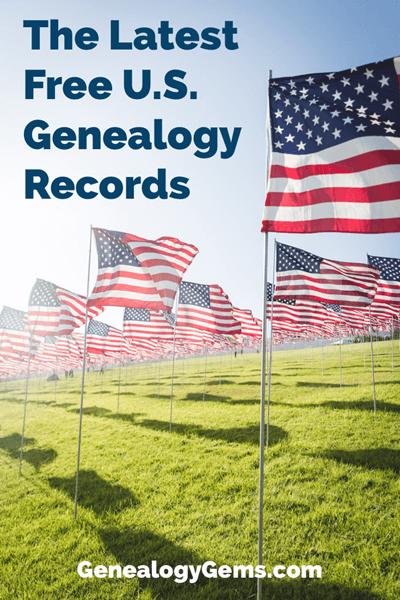 Alabama Deaths, 1908-1974
Alabama Deaths, 1908-1974
697 Added indexed records to an existing collection
Alabama, County Birth Registers, 1881-1930
6,638 Added indexed records to an existing collection
Alabama, Friends of Magnolia Cemetery, Funeral Books, 1911-1965
6,606 Added indexed records to an existing collection
California, Lassen County, State Board of Health, Burial Permits, 1931-1988
800 Added indexed records to an existing collection
Georgia, County Delayed Birth and Death Records, 1870-1960
7687 Added indexed records to an existing collection
Hawaii, Board of Health, Marriage Record Indexes, 1909-1989
10,729 Added indexed records to an existing collection
Illinois, Stark County Circuit Court, Stark County Naturalization Records
560 New indexed records collection
Louisiana, New Orleans, Interment Registers, 1836-1972
12,755 Added indexed records to an existing collection
Louisiana, Orleans Parish, Birth Records, 1819-1906
30,826 Added indexed records to an existing collection
Mississippi, Adams County, Natchez Death Index, 1835-1905
168 Added indexed records to an existing collection
Missouri, County Marriage, Naturalization, and Court Records, 1800-1991
5,678 Added indexed records to an existing collection
Nebraska, Grand Army of the Republic, Burial Records, 1861-1948
364 Added indexed records to an existing collection
North Carolina, Wake County, Death Records, 1900-1909
2,537 Added indexed records to an existing collection
South Carolina, Charleston County, Charleston, Birth Registers, 1901-1926
601 Added indexed records to an existing collection
Tennessee, Board of Health, Shelby County, Memphis Death Records, 1848-1913
1,061 New indexed records collection
Texas, Harrison County Delayed Birth Records, 1860-1933
196 Added indexed records to an existing collection
United States, GenealogyBank Historical Newspaper Obituaries, 1815-2011
98,269 Added indexed records to an existing collection
United States, Iowa Naturalization Records, 1859-1990
55,114 New indexed records collection
United States, Louisiana, Passenger Departures from New Orleans, 1867-1871
5,123 New indexed records collection
United States Census (Slave Schedule), 1860
4,429,408 Added indexed records to an existing collection
Virginia, Slave Birth Index, 1853-1866
13,135 Added indexed records to an existing collection
Wisconsin, Milwaukee, Pilgrim’s Rest Cemetery, Interment Records, 1880-1979
300 Added indexed records to an existing collection
Wales, Anglesey, Parish Registers, 1538-1912
281,418 Added indexed records and images to an existing collection
The Latest from Ancestry.com
Obituaries are a staple of genealogical research. Here’s the latest from the folks at Ancestry:
“Ancestry® updated its collection of US obituaries by combing through millions of digital obituaries to key names, relationships and other facts so members can now easily search these records with just one click.
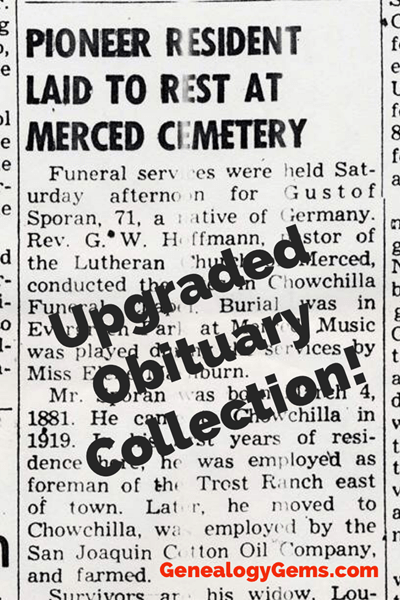
This initiative first announced at RootsTech uses new sophisticated artificial intelligence technology.
The new Newspapers.com Obituary Collection and the upgraded Ancestry U.S. Obituary Collection will expand Ancestry’s unparalleled historical record collections that enable people around the world to uncover their family history, spark their own journey of discovery and inspire meaningful conversations.
- Obituary collections include over 262 million worldwide obituaries and death announcements with almost 1 billionsearchable family members
- US Obituary Collection, 1930-Current search is the world’s largest, searchable digital archive, now includes 4x more searchable family members
- Newspapers.com Obituary Index includes facts from nearly 200 millionNewspapers.com obituaries
- Newspapers.com is the largest online newspaper archive, with over 525+ million pages of historical newspapers, including obituaries, from thousands of printed newspapers across the United States and beyond.
Members with an Ancestry All Access or Newspapers.com Basic subscription have a 1-click option to view the full obituary on Newspapers.com. Some images may require a Publisher Extra subscription as certain newspapers require additional licenses to view their content.”
Visit Ancestry here.
Visit Newspaper.com here.
Other Unique Collections Updated
From the State Archives of North Carolina blog comes a very interesting addition ton an existing Civil War digital collection:
A selection of 12 volumes from the Soldiers’ Home Association have been added to the Civil War digital collection. These volumes document the history of medical care for veterans and the elderly around the turn of the 19th century.”
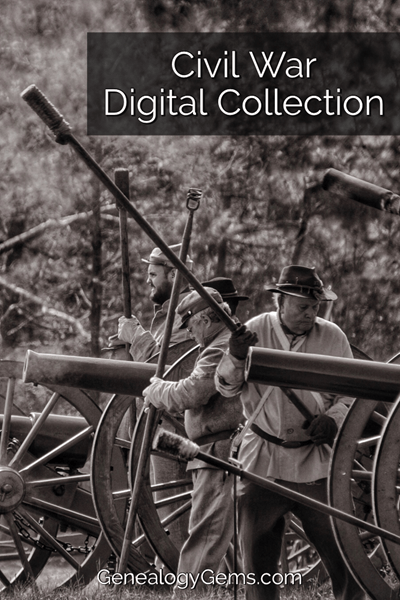
“These volumes provide recorded information on veterans’ military service, illnesses or injuries that might not have been recorded elsewhere. Some volumes include patients’ requests for their burial and funeral wishes. The volumes included are listed below:
Roll Book, 1890-1911
Register, 1890-1917
Record of Inmates, 1896-1924
Record of Inmates, 1925-1936
Record of Clothing Issued, 1926-1934
Hospital Patients, 1908-1916
Hospital Register, 1911-1919
Hospital Register, 1925-1930
Hospital Night Orders, 1918-1919
Hospital Night Orders, 1919
Hospital Night Orders, 1924
Hospital Night Orders, 1928-1929″
New British Genealogy Records

1801 Census
Discover your Scouse ancestor’s address, occupation and who they were living with in 1801. Findmypast now offers over 13,000 new and exclusive early census records. Don’t miss the images because they provide additional information about your ancestor’s abode.
The 1801 census was the first official census to be carried out in Britain. It estimated the population of England and Wales to be 8.9 million, and that of Scotland to be 1.6 million.
The 1801 census comprised two parts:
- the first was related to the number of people, their occupations, and numbers of families and houses.
- The second was a collection of the numbers of baptisms, marriages and burials, thus providing an indication of the rate at which the population was increasing or decreasing.
Click the following link to search the collection: 1801 Lancashire, Liverpool Census
Cornwall Burials
Over 75,000 new records covering 52 parishes across the Cornish peninsula are now available to search at Findmypast.
These transcripts reveal 5 key pieces of information:
- when your ancestor was buried
- where your ancestor was buried
- their age at death,
- residence
- and relatives’ names.
Click here to search the Cornwall Burials collection.
Kent Burials
And finally, Findmypast has added 12,000 new records to their collection last week. The majority of these new additions cover Swanscombe municipal cemetery and will reveal where and when your ancestor was buried as well as the names of their spouse and father. Click here to search the Kent Burial records.
New Records Coming Soon
Recently announced on the University of Georgia website:
“Through a new partnership with Google, about 120,000 of the Libraries’ 4.5 million volumes will be digitized, allowing further access to literary, historic, scientific and reference books and journals through UGA’s library catalog as well as one of the largest digital book collections in the world.”

“In addition to more modern materials that will be available for preview online, other examples of volumes available in full text include shipping registers from as far back as 1764 and Atlanta city directories dating back to 1870.
The project also advances a longstanding effort to provide digital access to state and federal government publications, and free digital access will be available to works by Balzac, Sir Francis Bacon, Robert Louis Stevenson, Thomas Hardy and other historically significant authors, thanks to UGA Libraries.”
Read the full post here.
What Did You Discover this Week?
Did one of these new and updated digital genealogy collections deliver what you’ve been waiting for? Please share your discovering in the Comments below. And click here to subscribe to the free Genealogy Gems newsletter to receive all the latest in new and updated genealogy records for your family history.
by Lisa Cooke | Jan 21, 2017 | 01 What's New, Ancestry, Census, Legacy Tree Genealogists |
So, you think there might be a missing census page? Whether it’s a missing census or a missing family, my special guest, professional genealogist Kate Eakman from Legacy Tree Genealogists has strategies to help you figure it out. She has just the answers you need to find your ‘missing’ family.
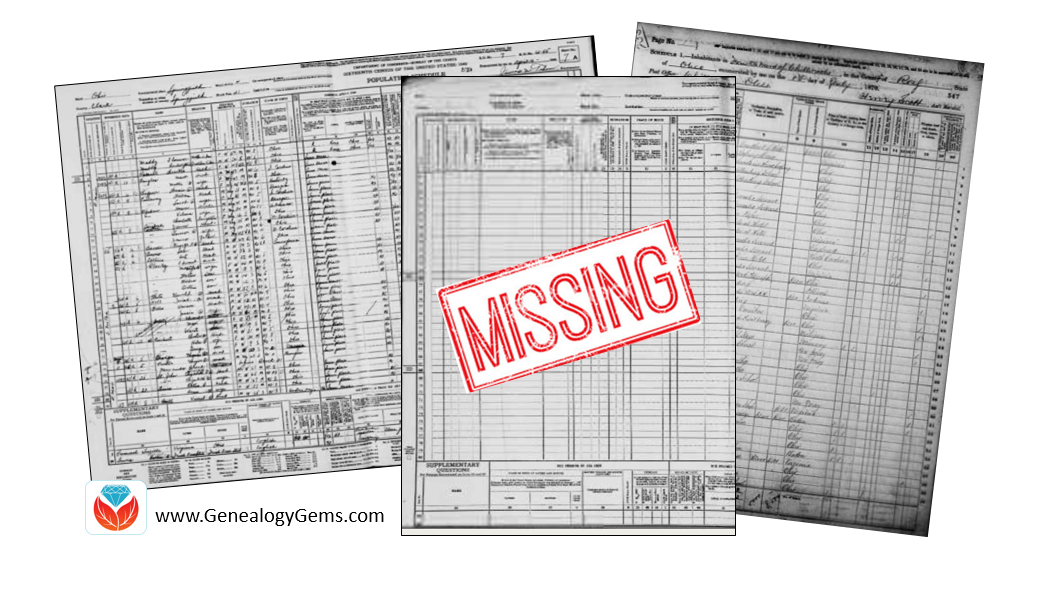
A Genealogy Gems reader doing genealogy research in New Jersey has lost her family! Well not literally, but she can’t find them in the 1940 U.S. Census. Here’s the email I recently received from her:
I am having a problem finding my mother and grandparents in the 1940 census. My grandfather, William Charles Opfer, was born on October 15 1900. I can find him in the 1930 census living in Glouescter Township, (Unincorporated Grenloch) Camden County, New Jersey. He is living with his wife Kathryn (Katharine) Opfer and three children: William C Jr, Robert, and Nancy (my mother).
When I search the 1940 census on Ancestry nothing shows up. So I went to the government web site and converted the 1930 Enumeration District to the 1940 Enumeration District. The 1940 Enumeration Districts were 4-57, 4-58, and 4-61. I then went through all of the pages for each of the districts looking for William C. Opfer. I did this on Ancestry, Family Search, and NARA. No William C. Opfer.
I then went back to the 1930 census and looked at his neighbors. I searched for each of the 13 heads-of-household neighbors from the 1930 census. Two had moved 1940 and I found them. I could not find the other neighbors in the 1940 census. I am wondering if a page from the 1940 census did not get scanned? Is there somewhere else I could look?
Missing Census Answers from Kate Eakman, Legacy Tree Genealogists
First, let me say how impressed I am with this Gem’s research and her dedication to finding this census report. She has made some very thorough searches and performed a number of advanced genealogical techniques in her quest for the 1940 U.S. Census page. It hardly seems fair that all that work didn’t yield the success she surely earned.
The government website she referenced is the National Archives 1940 Census page. The use of the page “1930 Records Search” allowed her to simply locate her grandfather in the 1930 U.S. Census. Then, by clicking a few buttons, discover the corresponding enumeration districts (ED) for the 1930 ED in which he and his family lived: 4-57, 4-58, and 4-61.

I, too, have scrolled through page after page searching for that one elusive name and we know how tedious that task can be! Using three different sites was a good strategy and one that we employ ourselves here at Legacy Tree Genealogists. Different images might be easier or more difficult to read, although in the case of these three EDs, the copies seemed to be uniformly easy to read.
The first two EDs were for Blackwood, an unincorporated part of Camden County, New Jersey. The third one was for the Lakeland Tuberculosis Hospital, unlikely to have housed the entire family, but certainly worth looking through in case one Opfer was a patient there.
ED 4-58 had an interesting variation at the end of the report. The last two pages were not 15A and 15B, as would be expected, but were 61A and 61B. This indicates these households were enumerated at a later date than were their neighbors. Because federal law requires every household to be counted, and because not everyone was at home when the enumerator arrived, the enumerator had to return on a different day and attempt to gather the necessary information for those families. They were recorded separately, beginning with page 61A.
People living in hotels, trailer camps, and other places normally designed for single-night stays were enumerated a week after the initial enumeration and those pages are numbered beginning with 81A. Not every ED has a 61 or an 81 page, but if you see one, now you know why the page numbers suddenly changed so dramatically.
The writer’s use of Elizabeth Shown Mills’ FAN Club was an excellent idea, too. FAN, an acronym for Friends, Associates, and Neighbors, takes advantage of the fact that people, in general, tend to remain geographically close to the people they know. [Read more about this in our post, “The Genealogy FAN Club Principle Overcomes Genealogy Brick Walls“] If a portion of a community moves, they tend to move together and relocate in the same general area of their new location. Her instincts to use this tool were excellent, even if they did not produce the desired results. This falls under the heading of “reasonably exhaustive research” and should always be included when someone, or in this case something, can’t be found, but should be there.
The fact that the researcher was able to locate only two of those neighbors could be explained, in part, by the fact that so many were in their 60s, 70s, and even 90s in 1930. They simply may have passed away in the intervening ten years. Another explanation, particularly for the working families, is that the Great Depression caused many families to move in order to find employment.
This may have been true for the Opfers. We noticed in 1930, William was employed as a supervisor for Reading Transportation. While supervisors were important to the operation of any transportation company, it is possible William found himself unemployed, as was true for millions of other Americans. If that happened, he and his family could have moved anywhere in the United States in an effort to find work. Alternatively, William may have left to find work while Kathryn and the children lived by themselves in reduced circumstances, or with family or friends.
To this end, I searched for William and Kathryn, and then each of the three children individually, in the hope of locating one or more family members. Using the “less is more” strategy which is often an important part of genealogical research, I searched with and without the family members’ ages, places of birth, and other family member’s names. Because the surname “Opfer” might have been misheard by the enumerator or grossly misspelled, I even searched for the various members of the family with no surname. Since we did not know where the family may have lived between 1930 and 1944, we included all of New Jersey, Delaware (the home state of Kathryn), as well as neighboring Pennsylvania and New York in our searches. The lack of positive results meant we needed to expand our search to the Eastern seaboard, and then the entire United States.
We also identified the names of William’s and Kathryn’s parents, William and Sallie Opfer and Raymond and Corrine Mason, and searched their households and neighborhoods for William and Kathryn. They were not there. Walter, William’s younger brother, was not hosting the family, either.
The writer had asked if it was possible that a page from the 1940 U.S. Census did not get scanned. Since the 1940 census has only been available for four years, it is still possible, although not probable, that there are one or more pages missing unbeknownst to anyone. Our research revealed only a few pages from a couple EDs in Ohio and South Dakota that were missing from the FamilySearch collection. There is no indication anywhere that there are missing pages from New Jersey. In addition, the pages in the three possible EDs for the Opfers were all included and in the correct numerical order, with no indication of any missing pages at the end. Therefore, I think we must conclude that missing pages do not explain the Opfer family’s disappearance.
Other Databases to Help
There are two other databases which might provide some insight into the location of the Opfer family. The first is the set of 1942 World War II draft registration cards. All men between the ages of 18 and 65 were required to register for this draft. The draft registration cards would have included the address at which William lived in 1942; however, there was no card for a man named William Opfer (or with only the surname “Opfer”) born between 1895 and 1905.
The final search was the database of city directories. A poorly-indexed city directory reported the Opfers lived in Haddonfield, New Jersey in 1943, but there are two directories contained in the same book, and the listing was actually for 1947. It reported William and Katherine lived at 209 Washington Avenue with their children William and his wife, Robert, and Nancy. William’s brother, Walter, and his wife Edith lived nearby. Unfortunately, the search for them in 1940 revealed that 79-year-old widower William Pape lived at that address with his household servants who were not the Opfer’s.
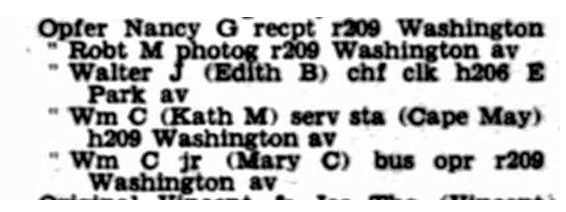
The William Opfer family in Haddonfield, New Jersey in 1947.Photo courtesy Ancestry.
Although the turmoil and upheaval of the Great Depression meant families were scattered, and it would have been easy to miss enumerating many households in the mid-1930s, by 1940 the U.S. was recovering from the effects of the Depression. Some agencies, such as the Works Progress Administration (WPA) and the CCC (Civilian Conservation Corps), were in place to provide work for men. Many war-related industries on both coasts were revived by the Allies’ efforts to stop Hitler.
In other words, there should have been work and stability for the Opfer family by 1940, and they ought to have appeared in a census report. The evidence of the 1930 census and the 1947 city directory strongly suggest they remained in or close to New Jersey, but all of the efforts to locate them have failed to yield positive results.
One Last Scenario
One possible scenario which would explain the Opfers apparent absence from the 1940 census is a simple one: perhaps the family was in the process of moving from one location to another in the month of April when the census was enumerated. Although the census was supposed to be enumerated on 1 April, the reality is that it was simply impossible to knock on every door and obtain the necessary information in one day. Some enumeration districts were fully counted by the 4th of the month. Other places were not completed until the 30th. This was true even in the same town.
If the Opfers had moved across the street from 206 Washington Avenue to 209 Washington Avenue in Haddonfield, for instance, between the 5th and the 14th of April, they would have moved from one enumeration district to another. Because the 209 Washington Avenue address had been enumerated on 4 April, they would not have been counted in that new location. And, because the 206 Washington Avenue address was not enumerated until the 15th of the month, they would not have been included in that EDs census report. We have seen this happen in the reverse and a family was enumerated twice because they moved during the enumeration, so it certainly could have happened the other way around. This is the only explanation we can find to explain the absence of the Opfers from the 1940 U.S. Census.
More About Kate Eakman at Legacy Tree Genealogists and SAVE $100!
 Kate Eakman grew up hearing Civil War stories at her father’s knee and fell in love with history and genealogy at an early age. With a master’s degree in history and over 20 years experience as a genealogist, Kate has worked her magic on hundreds of family trees and narratives.
Kate Eakman grew up hearing Civil War stories at her father’s knee and fell in love with history and genealogy at an early age. With a master’s degree in history and over 20 years experience as a genealogist, Kate has worked her magic on hundreds of family trees and narratives.
Areas of expertise:
-Native American Genealogy
-U.S. Civil War & Victorian America
-Narrative Biographies
-Irish Genealogy
The team of expert genealogists at Legacy Tree Genealogists can help bust through your brick walls. They do the research and you enjoy the discoveries!
by Lisa Cooke | Feb 6, 2015 | 01 What's New, Canadian, Google Earth, History, Maps, Military, United States
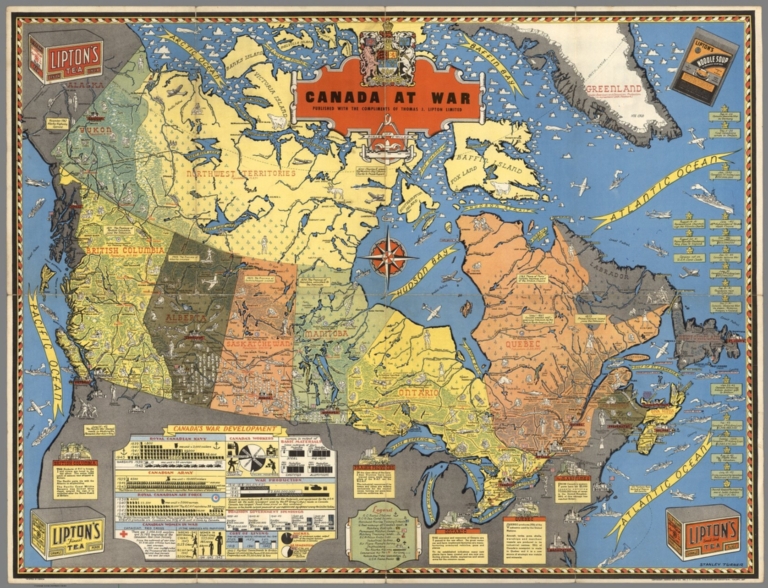
Canada at War by Stanley Turner, 1944. Online at the David Rumsey Map Collection. Click on image for full citation and to access image.
During World War II, millions of people anxiously followed the progress of battles and troop movements that affected their loved ones. Artists and map-makers stepped up to provide colorful, action-packed maps.
Toronto artist Stanley Turner was one of these. He created a series of maps between 1942 and 1945 that were printed and licensed as promotional giveaways to businesses in Canada and the U.S. Today you can find Turner’s maps digitized at the David Rumsey Map Collection.
Stanley wasn’t the only one making these beautiful maps. Read about Richard Eddes Harrison and the big changes in popular cartography during the war in my blog post, “World War II: A Revolution in Map-Making.”
Fast-forward 60 years in time, and the latest revolution in map-making and information-sharing is where? On Google Earth! Google Earth is packed with topography, but also shows us man-made features like roads and bridges, geographic boundaries, historical maps and photographs and so much more. These help us understand things like movements of our ancestors–whether they were troops in World War II or settlers in distant places.
 Want to learn more about using Google Earth for genealogy (or the Google Earth Pro version that was just released FREE to the public)? Become a Genealogy Gems Premium member. You’ll have access to video classes like these:
Want to learn more about using Google Earth for genealogy (or the Google Earth Pro version that was just released FREE to the public)? Become a Genealogy Gems Premium member. You’ll have access to video classes like these:
- Time Travel with Google Earth
- 5 Ways to Enhance Your Research with Old Maps (this class’ retail value alone is $39.95)
Premium Membership is a bargain at only $29.95 for an entire year’s access, plus right now you get the free bonus ebook Lisa Louise Cooke’s 84 Best Tips, Tricks & Tools from Family Tree Magazine. Click here to learn more about Premium Membership.
by Lisa Cooke | Sep 27, 2017 | 01 What's New, Genealogy Gems Podcast
Genealogy Gems Podcast Episode 208
with Lisa Louise Cooke
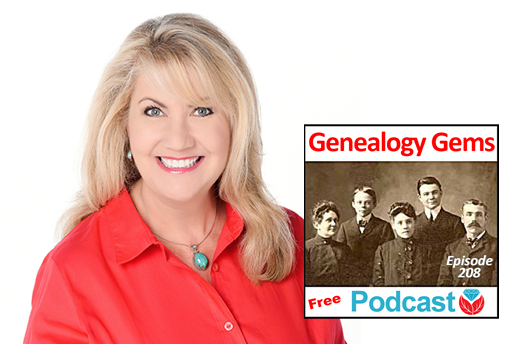
In this episode:
- A free webinar!
- Great comments from you: An inspiring Google Books success story, how one listener gets her shy husband talking about his life story, and a listener’s own version of the poem, “Where I’m From”
- The Archive Lady talks to us about historical scrapbooks at archives that may be packed with genealogy gems for us
- A genealogy hero who saved a life story
- Your first look at RootsTech 2018
FREE GENEALOGY WEBINAR
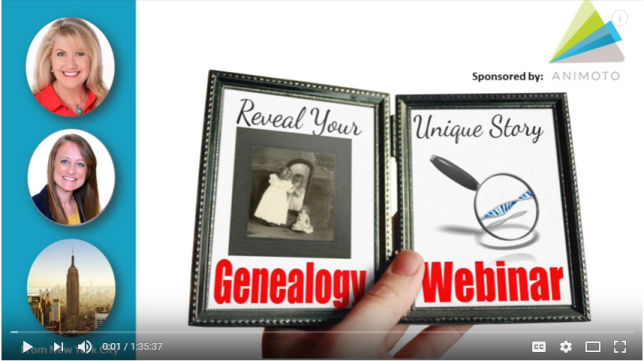
“Reveal Your Unique Story through DNA & Family History”
Handouts:
Googling and Making Videos with Lisa Louise Cooke
Newspaper Research Worksheet from Lisa Louise Cooke
Genetic Genealogy: Here’s What You Need to Know from Your DNA Guide Diahan Southard
NEWS: FIRST LOOK AT ROOTSTECH 2018
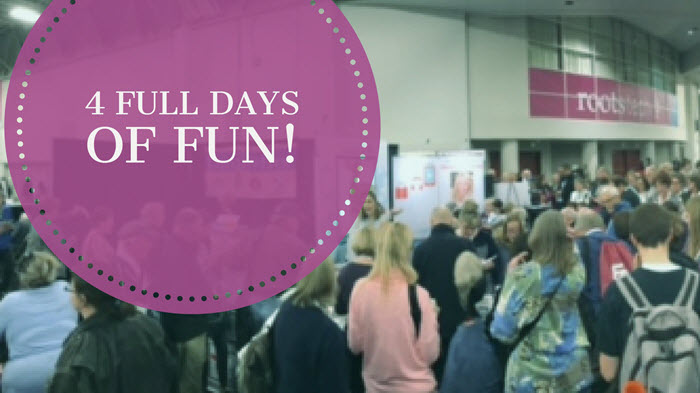
Going to RootsTech for the first time? Read this RootsTech Q&A.
MAILBOX: PAT INTERVIEWS HER SHY HUSBAND

“Remembering Dad” video
Pat’s tip: When someone is shy about sharing life stories, interview them informally while traveling. Pat uses her iPad to transcribe his responses, then polishes it up when she gets home and transfers it to her own computer. “Eventually we will have enough to write the story of his life, with lots of pictures. And it’s completely painless.”
MAILBOX: GOOGLE BOOKS SUCCESS STORY FROM KIM
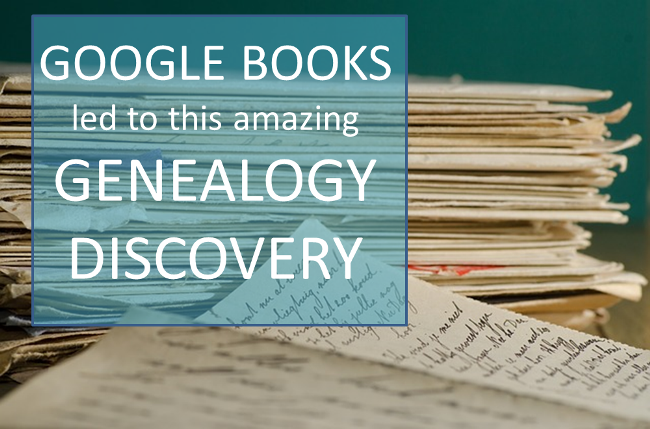
Click here for another inspiring genealogy discovery using Google Books?with how-to tips and a free video preview of Lisa Louise Cooke’s Premium video tutorial, “Google Books: The Tool You Need Every Day”
MAILBOX: “WHERE I’M FROM” POEM SUBMISSION
Genealogy Gems Podcast Episode 185: Learn more about the “Where I’m From” poetry project and hear a conversation with the original author, Kentucky poet laureate George Ella Lyon.
THE ARCHIVE LADY: HISTORICAL SCRAPBOOKS
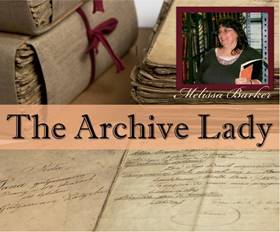
Scrapbooks are one of my favorite record sources to do genealogy research in and to also process in the archives. There are all kinds of scrapbooks; each and every one is unique and one-of-a-kind. They were put together with love and the hope that what was saved and pasted onto those pages will be remembered.
The origins of scrapbooking is said to go back to the 15th century in England and it is still a hobby enjoyed by many today. Most archives, libraries, historical and genealogical societies have scrapbooks in their collections. They will most likely be found in the Manuscript Collection as part of a specifically named collection.
Scrapbooks contain all kinds of wonderful genealogical records, photographs and ephemera. There is even a scrapbook in the Houston County, Tennessee Archives that has candy bar wrappers pasted in it. This particular scrapbook is one of my absolute favorites. It was compiled and owned by Evelyn Ellis and dates to the 1930’s and 1940’s.

Among the normal newspaper clippings and event programs are interesting pieces such as a Baby Ruth candy bar wrapper with a handwritten note by Evelyn that reads “Always remember June 11, 1938 at Beach Grove at the Ice Cream Supper.” There is also an original ticket pasted into the scrapbook from the Grand Ole Opry in Nashville, Tennessee where Evelyn Ellis visited and recorded her comments on April 1, 1939.
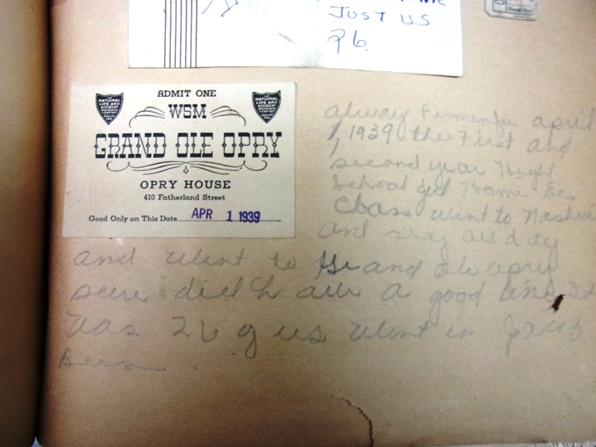
There are scrapbooks for just about any subject. Aside from personal scrapbooks, you can find war scrapbooks, obituary clipping scrapbooks and scrapbooks that collected and recorded local or national events. The obituaries found in scrapbooks could be a real find because sometimes they are the only pieces of the newspaper that survive and can be a treasure trove for any genealogist. Many scrapbooks contain one-of-a-kind documents, photographs and ephemera.
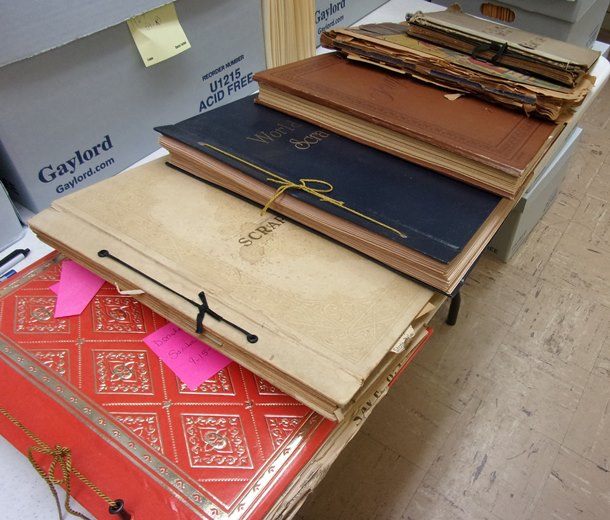
To find scrapbooks in an archive, ask the archivist if they have any scrapbooks in their records collections. Many times scrapbooks are housed with a particular manuscript collection and will be listed in the finding aid. Some archives have a collection of just scrapbooks that have been donated to them and can be easily accessed. Most scrapbooks will not be on research shelves and will be stored in back rooms at the archives and will have to be requested. You should also check the archives online catalog for any listings of scrapbooks before you jump in the car and drive to the archives.
I encourage all genealogists to check with the archive in the area where your ancestors were from and see if they have any scrapbooks in their archived records collections. Scrapbooks are like time capsules: you don’t know what will be found in them until you open them up.
BONUS CONTENT for Genealogy Gems App Users

If you’re listening through the Genealogy Gems app, your bonus content for this episode is a PDF with tips for what to do if your own scrapbook gets wet. The Genealogy Gems app is FREE in Google Play and is only $2.99 for Windows, iPhone and iPad users.
ANIMOTO

Start creating fabulous, irresistible videos about your family history with Animoto.com. You don’t need special video-editing skills: just drag and drop your photos and videos, pick a layout and music, add a little text and voila! You’ve got an awesome video! Try this out for yourself at Animoto.
MYHERITAGE.COM
MyHeritage is the place to make connections with relatives overseas, particularly with those who may still live in your ancestral homeland. Click here to see what MyHeritage can do for you: it’s free to get started.
GEM: SAVING A LIFE STORY
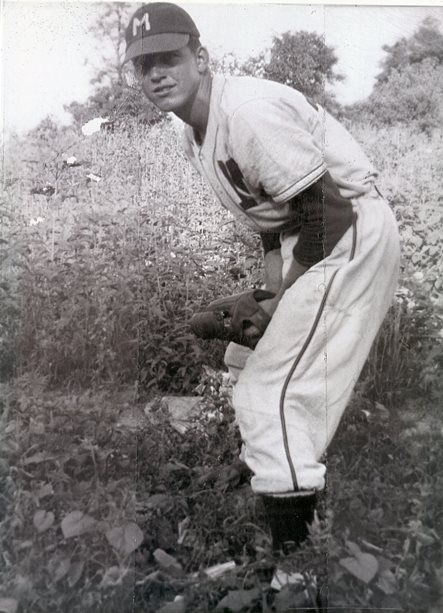
Original story on SWVA Today: “String of Pearls: Marion’s Bob White Shares Family History Collection” by Margaret Linford, Columnist
Smyth County Public Library Local History webpage
Genealogy Gems how-to resources to help you:
Video record a loved one telling their life stories
How to video record a fantastic family history interview
How to create a family history video with Animoto
Digitize and share your research and your own life story: Interview with Larsen Digital in Genealogy Gems Podcast episode 183
How to Start Blogging series in the free Family History: Genealogy Made Easy podcast (episodes 38-42) and this article: 3 Ways to Improve Your Genealogy Blog
RootsMagic family history software has publishing tools (for print and online publishing):
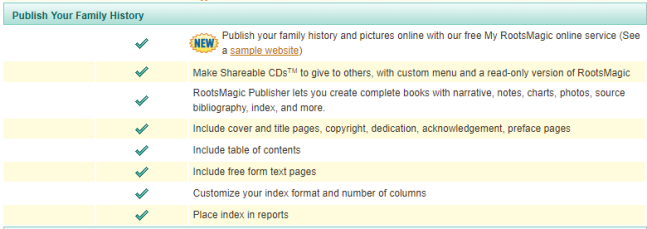

Visit www.RootsMagic.com
Lisa Louise Cooke uses and recommends RootsMagic family history software. From within RootsMagic, you can search historical records on FamilySearch.org, Findmypast.com and MyHeritage.com. RootsMagic is now fully integrated with Ancestry.com: you can sync your RootsMagic trees with your Ancestry.com trees and search records on the site.
A BRILLIANT WAY TO “MEET” YOUR ANCESTOR
Your DNA Guide Diahan Southard shared this story from Christine:
“Friday night I brought out large cut out of my Grandmother, Christine Doering, sitting in an easy chair so it looks like she is talking with you, and I played a recording done in 1970’s of her talking and giggling about coming to America in 1896 at the age of 9. For some they had never heard her voice before.”
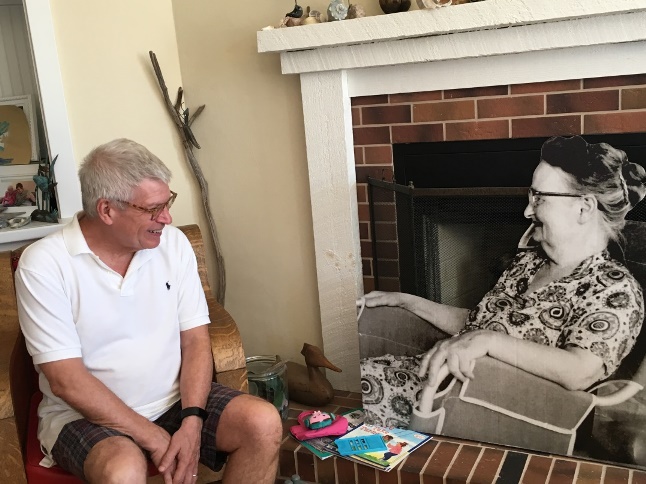
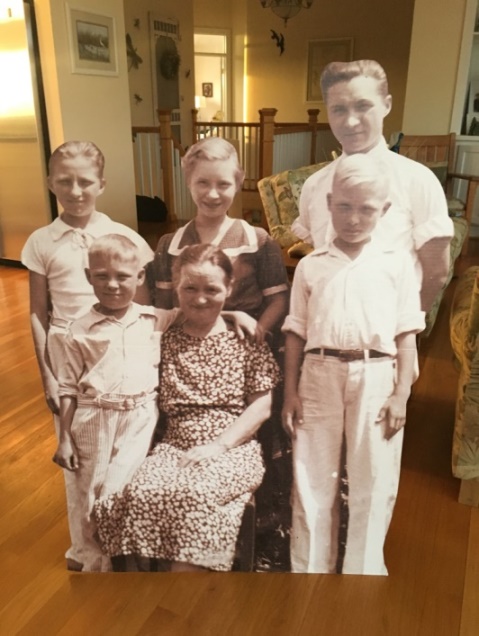
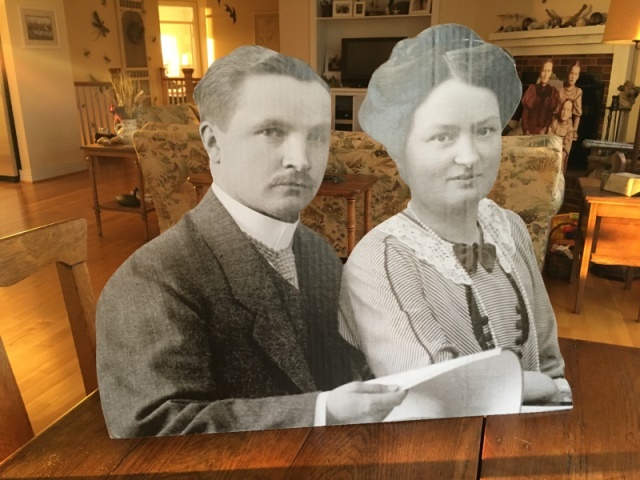
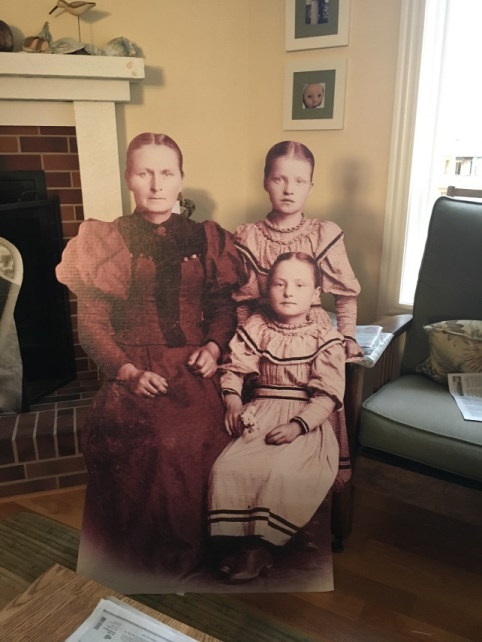
Subscribe to the free Genealogy Gems YouTube channel.
PRODUCTION CREDITS
Lisa Louise Cooke, Host and Producer
Sunny Morton, Editor
Diahan Southard, Your DNA Guide, Content Contributor
Vienna Thomas, Associate Producer
Hannah Fullerton, Production Assistant
Lacey Cooke, Service Manager
FREE NEWSLETTER:

Subscribe to the Genealogy Gems newsletter to receive a free weekly e-mail newsletter, with tips, inspiration and money-saving deals.
Resources
Download the episode
Download the show notes

 Alabama Deaths, 1908-1974
Alabama Deaths, 1908-1974





























